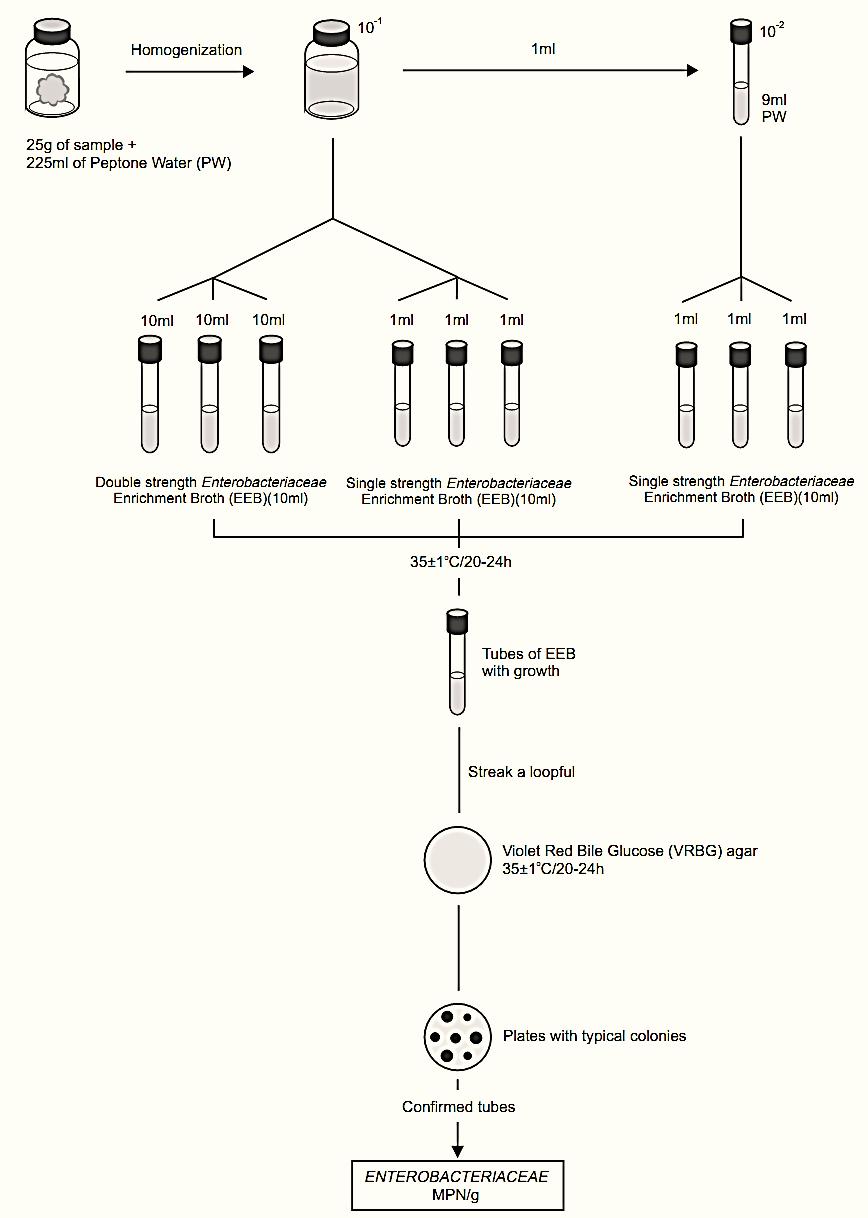


 النبات
النبات
 الحيوان
الحيوان
 الأحياء المجهرية
الأحياء المجهرية
 علم الأمراض
علم الأمراض
 التقانة الإحيائية
التقانة الإحيائية
 التقنية الحيوية المكروبية
التقنية الحيوية المكروبية
 التقنية الحياتية النانوية
التقنية الحياتية النانوية
 علم الأجنة
علم الأجنة
 الأحياء الجزيئي
الأحياء الجزيئي
 علم وظائف الأعضاء
علم وظائف الأعضاء
 الغدد
الغدد
 المضادات الحيوية
المضادات الحيوية| Most probable number (MPN) method APHA 2001 for Enterobacteriaceae in foods |
|
|
|
Read More
Date: 3-3-2016
Date: 6-3-2016
Date: 1-3-2016
|
Most probable number (MPN) method APHA 2001 for Enterobacteriaceae in foods
Method of the American Public Health Association
(APHA), as described in the 4th Edition of the Compendium of Methods for the Microbiological Examination of Foods (Kornacki and Johnson, 2001).
The enumeration of Enterobacteriaceae by the MPN method is indicated for samples with low counts, lower than the detection limit of the plate count method.
1 - Material required for analysis
Preparation of the samples and serial dilutions
• Diluent: 0.1% Peptone Water (PW) or Butterfield’s Phosphate Buffer
• Dilution tubes containing 9 ml 0.1% Peptone Water (PW) or Butterfield’s Phosphate Buffer
Enrichment and plating
• Enterobacteriaceae Enrichment Broth (EEB)
• Petri plates containing Violet Red Bile Glucose (VRBG) Agar
• Laboratory incubator set to 35 ± 1°C
2 - Procedure
A flowchart for the enumeration of Enterobacteriaceae in foods using the MPN method APHA 2001 is shown in Figure 1.
a) Preparation of the samples and serial dilutions.
Note a.1) If there is no need to quantify, but only to determine the presence/absence in the sample, inoculation can be done directly on Enterobacteriaceae enrichment broth (EEB), followed by incubation.

Figure 1 Scheme of analysis for the enumeration of Enterobacteriaceae in foods using the MPN method APHA 2001 (Kornacki and Johnson, 2001).
b) Inoculation (presumptive test). Inoculate three 10 ml-aliquots of the first dilution (10−1) in three tubes containing 10 ml of double strength Enterobacteriaceae Enrichment Broth (EEB), three 1 ml-aliquots of the 10−1 dilution in three tubes containing 10 ml of single strength EEB and three 1 ml-aliquots of the 10−2 dilution in three tubes containing 10 ml of single strength EEB.
c) Incubation. Incubate the EEB tubes at 35 ± 1°C/20–24 h and observe any growth. In case growth is observed, pass on to the subsequent items.
d) Confirmation of Enterobacteriaceae. From the culture of each tube exhibiting growth streak a loopful on a plate of Violet Red Bile Glucose Agar. Incubate the plates at 35 ± 1°C/20–24 h. Observe whether there is any growth of typical Enterobacteriaceae colonies (red purple, 0.5 mm or greater in diameter surrounded by a reddish halo indicating precipitation of the bile salts).
e) Calculating the results. Record the number of confirmed tubes and determine the MPN/g or MPN/ml.
References
Silva, N.D .; Taniwaki, M.H. ; Junqueira, V.C.A.; Silveira, N.F.A. , Nasdcimento , M.D.D. and Gomes ,R.A.R .(2013) . Microbiological examination methods of food and water a laboratory Manual. Institute of Food Technology – ITAL, Campinas, SP, Brazil .
Kornacki, J.L. & Johnson, J.L. (2001) Enterobacteriaceae, coliforms, and Escherichia coli as quality and safety indicators. In: Downes, F.P. & Ito, K. (eds). Compendium of Methods for the Microbio-logical Examination of Foods. 4th edition. Washington, American Public Health Association. Chapter 8, pp. 69–82.



|
|
|
|
التوتر والسرطان.. علماء يحذرون من "صلة خطيرة"
|
|
|
|
|
|
|
مرآة السيارة: مدى دقة عكسها للصورة الصحيحة
|
|
|
|
|
|
|
نحو شراكة وطنية متكاملة.. الأمين العام للعتبة الحسينية يبحث مع وكيل وزارة الخارجية آفاق التعاون المؤسسي
|
|
|